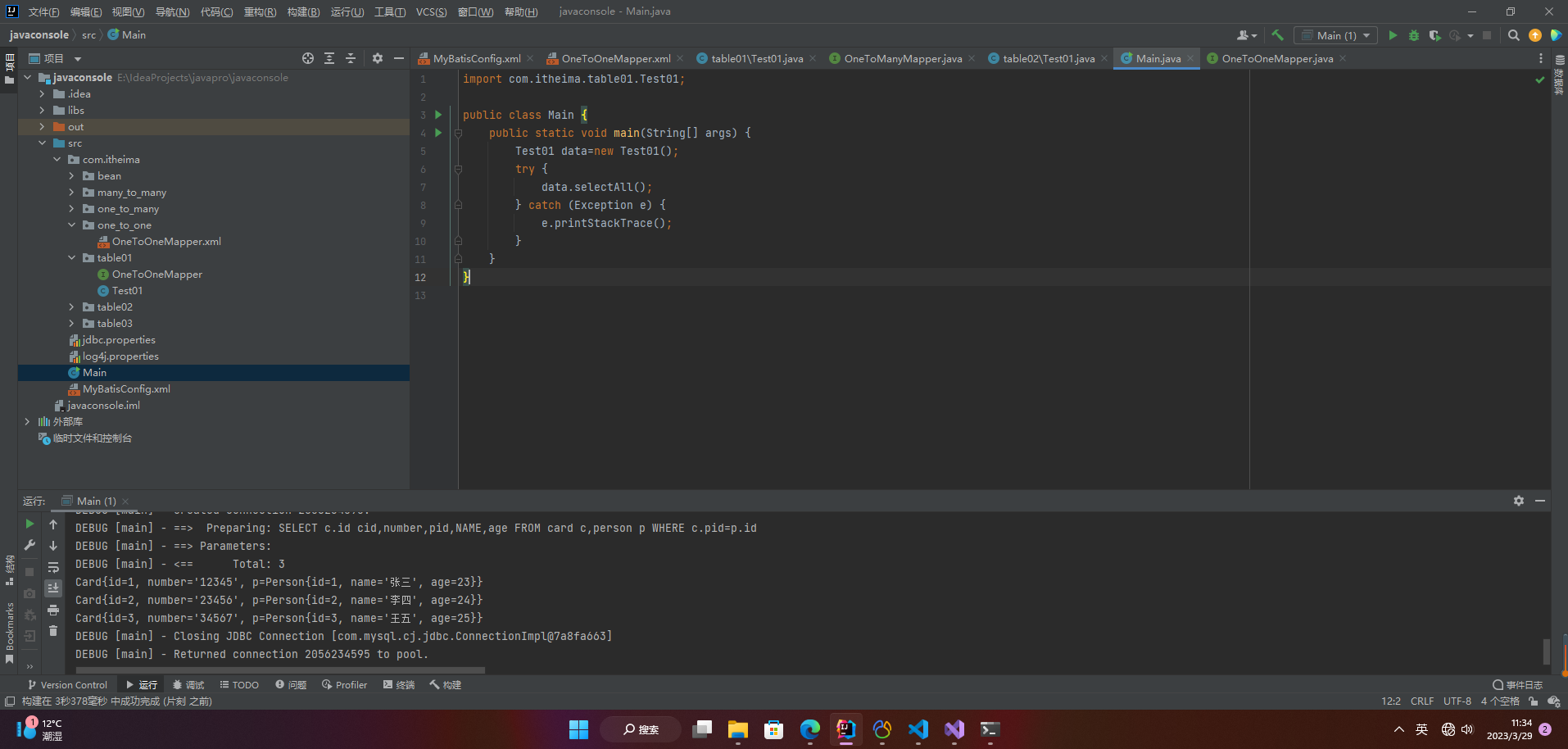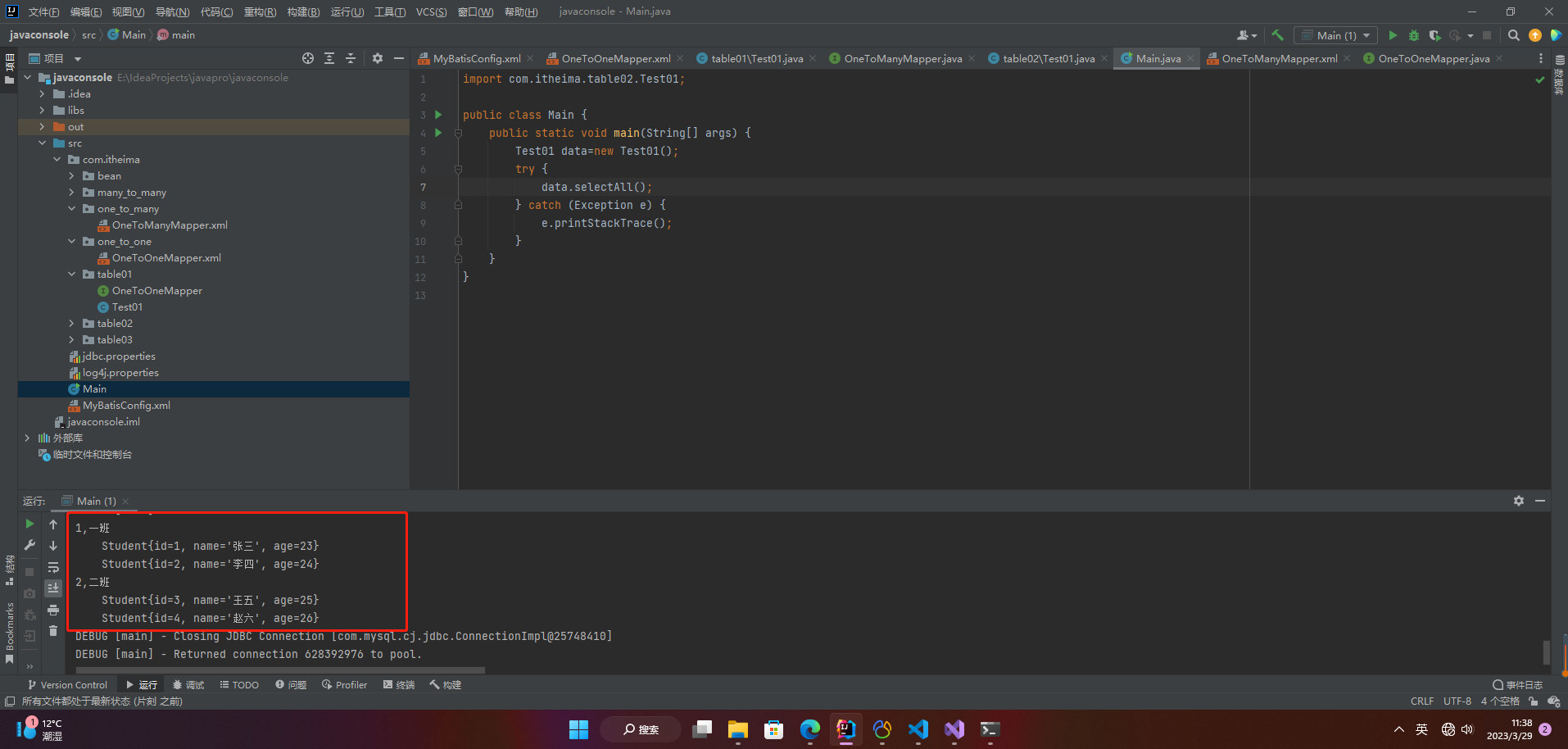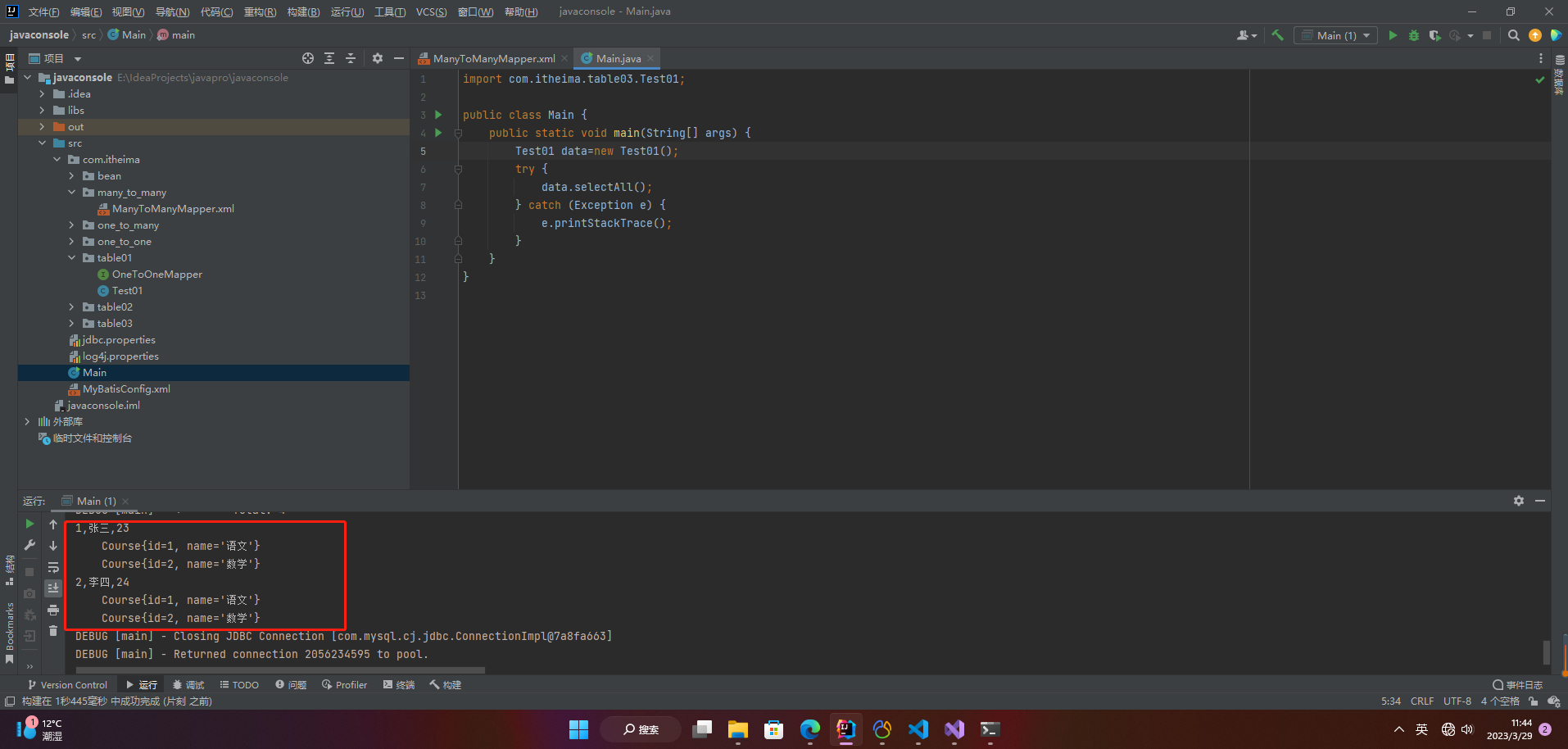一、MyBatis的多表操作
4.1 多表模型介绍
多表模型是一种关系型数据库设计模式,它使用多个表格来存储和管理数据。在多表模型中,每个表格都包含一组相关的数据,并使用外键等关系来与其他表格建立连接。这种模型通常用于处理复杂的数据结构,例如具有多个关系的实体或需要动态添加或删除属性的实体。
多表模型具有以下优点:
- 灵活性:多表模型可以轻松地适应数据结构的变化。您可以添加或删除表格,更改表格之间的关系,或者向表格中添加新的列。
- 数据完整性:使用外键等关系可以保证数据的完整性。例如,如果一个表格引用另一个表格中的数据,那么只有在另一个表格中存在该数据时,才能在当前表格中插入该数据。
- 数据查询:多表模型可以提高数据查询的效率。由于数据被分散在多个表格中,可以只查询需要的数据,而不是整个数据集。
- 数据安全:多表模型可以提高数据安全性。敏感数据可以存储在单独的表格中,并根据需要授权访问权限。
多表模型是一种有效的数据库设计模式,适用于处理复杂的数据结构和需要灵活性和数据完整性的应用程序。
多表模型分类如下:
- 一对一:在任意一方建立外键,关联对方的主键。
- 一对多:在多的一方建立外键,关联一的一方的主键。
- 多对多:借助中间表,中间表至少两个字段,分别关联两张表的主键。
4.2 多表模型一对一操作
-
一对一模型: 人和身份证,一个人只有一个身份证
-
代码实现
-
步骤一: sql语句准备
CREATE TABLE person( id INT PRIMARY KEY AUTO_INCREMENT, NAME VARCHAR(20), age INT ); INSERT INTO person VALUES (NULL,'张三',23); INSERT INTO person VALUES (NULL,'李四',24); INSERT INTO person VALUES (NULL,'王五',25); CREATE TABLE card( id INT PRIMARY KEY AUTO_INCREMENT, number VARCHAR(30), pid INT, CONSTRAINT cp_fk FOREIGN KEY (pid) REFERENCES person(id) ); INSERT INTO card VALUES (NULL,'12345',1); INSERT INTO card VALUES (NULL,'23456',2); INSERT INTO card VALUES (NULL,'34567',3); -
步骤二:配置文件
<?xml version="1.0" encoding="UTF-8" ?> <!DOCTYPE mapper PUBLIC "-//mybatis.org//DTD Mapper 3.0//EN" "http://mybatis.org/dtd/mybatis-3-mapper.dtd"> <mapper namespace="com.itheima.table01.OneToOneMapper"> <!--配置字段和实体对象属性的映射关系--> <resultMap id="oneToOne" type="card"> <id column="cid" property="id" /> <result column="number" property="number" /> <!-- association:配置被包含对象的映射关系 property:被包含对象的变量名 javaType:被包含对象的数据类型 --> <association property="p" javaType="person"> <id column="pid" property="id" /> <result column="name" property="name" /> <result column="age" property="age" /> </association> </resultMap> <select id="selectAll" resultMap="oneToOne"> SELECT c.id cid,number,pid,NAME,age FROM card c,person p WHERE c.pid=p.id </select> </mapper>package com.itheima.table02; import com.itheima.bean.Classes; import java.util.List; public interface OneToManyMapper { //查询全部 public abstract List<Classes> selectAll(); } -
步骤三:测试类
@Test public void selectAll() throws Exception{ //1.加载核心配置文件 InputStream is = Resources.getResourceAsStream("MyBatisConfig.xml"); //2.获取SqlSession工厂对象 SqlSessionFactory sqlSessionFactory = new SqlSessionFactoryBuilder().build(is); //3.通过工厂对象获取SqlSession对象 SqlSession sqlSession = sqlSessionFactory.openSession(true); //4.获取OneToOneMapper接口的实现类对象 OneToOneMapper mapper = sqlSession.getMapper(OneToOneMapper.class); //5.调用实现类的方法,接收结果 List<Card> list = mapper.selectAll(); //6.处理结果 for (Card c : list) { System.out.println(c); } //7.释放资源 sqlSession.close(); is.close(); }
3.一对一配置总结:
<resultMap>:配置字段和对象属性的映射关系标签。 id 属性:唯一标识 type 属性:实体对象类型 <id>:配置主键映射关系标签。 <result>:配置非主键映射关系标签。 column 属性:表中字段名称 property 属性: 实体对象变量名称 <association>:配置被包含对象的映射关系标签。 property 属性:被包含对象的变量名 javaType 属性:被包含对象的数据类型 -

4.3 多表模型一对多操作
-
一对多模型: 一对多模型:班级和学生,一个班级可以有多个学生。
-
代码实现
-
步骤一: sql语句准备
CREATE TABLE classes( id INT PRIMARY KEY AUTO_INCREMENT, NAME VARCHAR(20) ); INSERT INTO classes VALUES (NULL,'一班'); INSERT INTO classes VALUES (NULL,'二班'); CREATE TABLE student( id INT PRIMARY KEY AUTO_INCREMENT, NAME VARCHAR(30), age INT, cid INT, CONSTRAINT cs_fk FOREIGN KEY (cid) REFERENCES classes(id) ); INSERT INTO student VALUES (NULL,'张三',23,1); INSERT INTO student VALUES (NULL,'李四',24,1); INSERT INTO student VALUES (NULL,'王五',25,2); INSERT INTO student VALUES (NULL,'赵六',26,2); -
步骤二:配置文件
<mapper namespace="com.itheima.table02.OneToManyMapper"> <resultMap id="oneToMany" type="classes"> <id column="cid" property="id"/> <result column="cname" property="name"/> <!-- collection:配置被包含的集合对象映射关系 property:被包含对象的变量名 ofType:被包含对象的实际数据类型 --> <collection property="students" ofType="student"> <id column="sid" property="id"/> <result column="sname" property="name"/> <result column="sage" property="age"/> </collection> </resultMap> <select id="selectAll" resultMap="oneToMany"> SELECT c.id cid,c.name cname,s.id sid,s.name sname,s.age sage FROM classes c,student s WHERE c.id=s.cid </select> </mapper> -
步骤三:测试类
@Test public void selectAll() throws Exception{ //1.加载核心配置文件 InputStream is = Resources.getResourceAsStream("MyBatisConfig.xml"); //2.获取SqlSession工厂对象 SqlSessionFactory sqlSessionFactory = new SqlSessionFactoryBuilder().build(is); //3.通过工厂对象获取SqlSession对象 SqlSession sqlSession = sqlSessionFactory.openSession(true); //4.获取OneToManyMapper接口的实现类对象 OneToManyMapper mapper = sqlSession.getMapper(OneToManyMapper.class); //5.调用实现类的方法,接收结果 List<Classes> classes = mapper.selectAll(); //6.处理结果 for (Classes cls : classes) { System.out.println(cls.getId() + "," + cls.getName()); List<Student> students = cls.getStudents(); for (Student student : students) { System.out.println("\t" + student); } } //7.释放资源 sqlSession.close(); is.close(); }
3.一对多配置文件总结:
<resultMap>:配置字段和对象属性的映射关系标签。 id 属性:唯一标识 type 属性:实体对象类型 <id>:配置主键映射关系标签。 <result>:配置非主键映射关系标签。 column 属性:表中字段名称 property 属性: 实体对象变量名称 <collection>:配置被包含集合对象的映射关系标签。 property 属性:被包含集合对象的变量名 ofType 属性:集合中保存的对象数据类型 -

4.4 多表模型多对多操作
-
多对多模型:学生和课程,一个学生可以选择多门课程、一个课程也可以被多个学生所选择。
-
代码实现
-
步骤一: sql语句准备
CREATE TABLE course( id INT PRIMARY KEY AUTO_INCREMENT, NAME VARCHAR(20) ); INSERT INTO course VALUES (NULL,'语文'); INSERT INTO course VALUES (NULL,'数学'); CREATE TABLE stu_cr( id INT PRIMARY KEY AUTO_INCREMENT, sid INT, cid INT, CONSTRAINT sc_fk1 FOREIGN KEY (sid) REFERENCES student(id), CONSTRAINT sc_fk2 FOREIGN KEY (cid) REFERENCES course(id) ); INSERT INTO stu_cr VALUES (NULL,1,1); INSERT INTO stu_cr VALUES (NULL,1,2); INSERT INTO stu_cr VALUES (NULL,2,1); INSERT INTO stu_cr VALUES (NULL,2,2); -
步骤二:配置文件
<?xml version="1.0" encoding="UTF-8" ?> <!DOCTYPE mapper PUBLIC "-//mybatis.org//DTD Mapper 3.0//EN" "http://mybatis.org/dtd/mybatis-3-mapper.dtd"> <mapper namespace="com.itheima.table03.ManyToManyMapper"> <resultMap id="manyToMany" type="student"> <id column="sid" property="id"/> <result column="sname" property="name"/> <result column="sage" property="age"/> <collection property="courses" ofType="course"> <id column="cid" property="id"/> <result column="cname" property="name"/> </collection> </resultMap> <select id="selectAll" resultMap="manyToMany"> SELECT sc.sid,s.name sname,s.age sage,sc.cid,c.name cname FROM student s,course c,stu_cr sc WHERE sc.sid=s.id AND sc.cid=c.id </select> </mapper> -
步骤三:测试类
@Test public void selectAll() throws Exception{ //1.加载核心配置文件 InputStream is = Resources.getResourceAsStream("MyBatisConfig.xml"); //2.获取SqlSession工厂对象 SqlSessionFactory sqlSessionFactory = new SqlSessionFactoryBuilder().build(is); //3.通过工厂对象获取SqlSession对象 SqlSession sqlSession = sqlSessionFactory.openSession(true); //4.获取ManyToManyMapper接口的实现类对象 ManyToManyMapper mapper = sqlSession.getMapper(ManyToManyMapper.class); //5.调用实现类的方法,接收结果 List<Student> students = mapper.selectAll(); //6.处理结果 for (Student student : students) { System.out.println(student.getId() + "," + student.getName() + "," + student.getAge()); List<Course> courses = student.getCourses(); for (Course cours : courses) { System.out.println("\t" + cours); } } //7.释放资源 sqlSession.close(); is.close(); }
3.多对多配置文件总结:
<resultMap>:配置字段和对象属性的映射关系标签。 id 属性:唯一标识 type 属性:实体对象类型 <id>:配置主键映射关系标签。 <result>:配置非主键映射关系标签。 column 属性:表中字段名称 property 属性: 实体对象变量名称 <collection>:配置被包含集合对象的映射关系标签。 property 属性:被包含集合对象的变量名 ofType 属性:集合中保存的对象数据类型 -

4.5 多表模型操作总结
<resultMap>:配置字段和对象属性的映射关系标签。
id 属性:唯一标识
type 属性:实体对象类型
<id>:配置主键映射关系标签。
<result>:配置非主键映射关系标签。
column 属性:表中字段名称
property 属性: 实体对象变量名称
<association>:配置被包含对象的映射关系标签。
property 属性:被包含对象的变量名
javaType 属性:被包含对象的数据类型
<collection>:配置被包含集合对象的映射关系标签。
property 属性:被包含集合对象的变量名
ofType 属性:集合中保存的对象数据类型